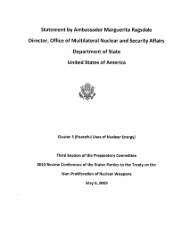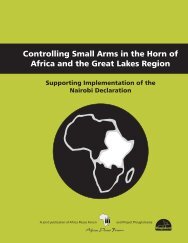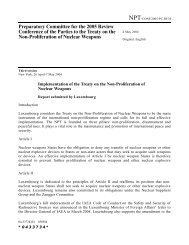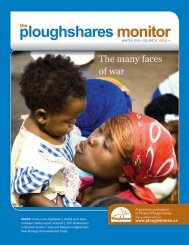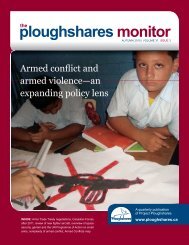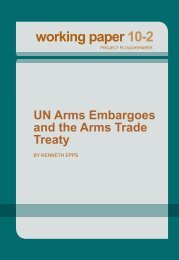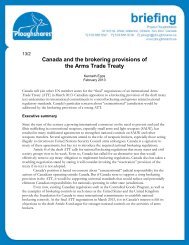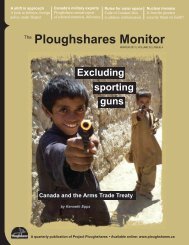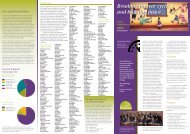Addressing Armed Violence in East Africa.pdf - Project Ploughshares
Addressing Armed Violence in East Africa.pdf - Project Ploughshares
Addressing Armed Violence in East Africa.pdf - Project Ploughshares
You also want an ePaper? Increase the reach of your titles
YUMPU automatically turns print PDFs into web optimized ePapers that Google loves.
<strong>Address<strong>in</strong>g</strong> <strong>Armed</strong> <strong>Violence</strong> <strong>in</strong> <strong>East</strong> <strong>Africa</strong>1. IntroductionThis cooperative study between a disarmament organisation,<strong>Project</strong> <strong>Ploughshares</strong>, and an <strong>in</strong>ternational Christian relief,development and advocacy organisation, World Vision(WV), was undertaken to document if and how World Visionpeacebuild<strong>in</strong>g and development <strong>in</strong>itiatives are contribut<strong>in</strong>g toreductions <strong>in</strong> armed violence. It also records the assessment ofthe impact of World Vision peacebuild<strong>in</strong>g activities by people<strong>in</strong> violence-affected communities. The research was undertaken<strong>in</strong> selected areas of Kenya, Uganda and Sudan over a threeweekperiod <strong>in</strong> September 2008.Because it is widely recognised that assistance delivered withoutsensitivity to conflict dynamics can make the conflict worse,development practitioners, <strong>in</strong>clud<strong>in</strong>g World Vision, have long<strong>in</strong>tegrated “Do No Harm” (DNH) strategies associated withMary B. Anderson <strong>in</strong>to relief or development programmes<strong>in</strong> areas affected by armed violence. Development and reliefresources represent a transfer of wealth, and therefore power,<strong>in</strong>to a community. If underly<strong>in</strong>g tensions or conflicts <strong>in</strong> thecommunity are not accounted for, external assistance canfavour one group over another, mak<strong>in</strong>g tensions worse. DNHstrategies would generally be expected <strong>in</strong> good developmentand relief programm<strong>in</strong>g.It is also clear that development <strong>in</strong>vestments can be wasted ifguns are be<strong>in</strong>g used to kill and <strong>in</strong>jure people, if <strong>in</strong>frastructureis be<strong>in</strong>g destroyed, if agricultural activity is be<strong>in</strong>g h<strong>in</strong>dered,if access to markets is <strong>in</strong>terrupted, or if people are <strong>in</strong> a stateof debilitat<strong>in</strong>g fear or are <strong>in</strong> flight from armed violence.Respond<strong>in</strong>g to gun violence, however, is not necessarily viewedas an important part of sound development programm<strong>in</strong>g – atleast not yet.<strong>Address<strong>in</strong>g</strong> armed violence through disarmament processesthat focus on <strong>in</strong>terrupt<strong>in</strong>g the supply of guns or remov<strong>in</strong>g themfrom post-conflict situations or from areas of armed crim<strong>in</strong>alviolence also has proven extremely difficult <strong>in</strong> practice. Indeed,<strong>in</strong> some cases disarmament has actually <strong>in</strong>creased the frequencyand <strong>in</strong>tensity of armed violence – for example, when there hasbeen an imbalance <strong>in</strong> weapons removal among rival groups.To date, development <strong>in</strong>terventions and disarmamentefforts have not rout<strong>in</strong>ely been l<strong>in</strong>ked <strong>in</strong> build<strong>in</strong>g susta<strong>in</strong>abledevelopment and susta<strong>in</strong>able peace <strong>in</strong> response to situations ofarmed conflict.NIGEL MARSH / World VisionA child <strong>in</strong> a displaced persons’ camp <strong>in</strong> <strong>East</strong>ern Uganda. Throughoutthe research, people reported be<strong>in</strong>g displaced due to armed violence.Countries <strong>in</strong> <strong>East</strong> <strong>Africa</strong>, which <strong>in</strong>clude Kenya, Uganda andSudan – the subjects of this research – consistently rank nearthe bottom of the United Nations Development Programme’sHuman Development Index. 1 They have been particularlyhard-hit by the pervasive presence of small arms and lightweapons. Part of the solution <strong>in</strong> build<strong>in</strong>g susta<strong>in</strong>able peace isthe control and removal of guns. Unfortunately, there are noeasy methods to control the supply of weapons to and betweenthese countries, which have suffered for decades from civil wars,<strong>in</strong>surgencies and wars between states. Multilateral agreementsto restrict the supply of weapons and to support disarmamentprograms are slowly be<strong>in</strong>g implemented but to date they havehad limited impact. 21 The HDI of the UNDP ranked 179 countries <strong>in</strong> 2008 based on 2006 statistics.The respective rank<strong>in</strong>gs for Kenya, Sudan and Uganda were 144, 146 and 156.See http://hdr.undp.org/en/reports/global/hdr2007-2008/2 The three states are politically bound by commitments under the UnitedNations Programme of Action to Prevent, Combat and Eradicate the Illicit Trade<strong>in</strong> Small Arms and Light Weapons <strong>in</strong> All Its Aspects (PoA), agreed <strong>in</strong> 2001. Theyalso are signatories to the legally b<strong>in</strong>d<strong>in</strong>g Nairobi Protocol for the Prevention,Control and Reduction of Small Arms and Light Weapons <strong>in</strong> the Great LakesRegion and the Horn of <strong>Africa</strong>, which entered <strong>in</strong>to force <strong>in</strong> 2006. Under theterms of the Nairobi Protocol the three states have established national focalpo<strong>in</strong>ts to coord<strong>in</strong>ate <strong>in</strong>formation-shar<strong>in</strong>g on Protocol implementation and, <strong>in</strong>keep<strong>in</strong>g with the PoA, Kenya and Uganda have produced National Action Planson Small Arms and Light Weapons. In addition, Kenya, Uganda and Sudanhave endorsed the Geneva Declaration on <strong>Armed</strong> <strong>Violence</strong> and Development(GD). Kenya is one of the orig<strong>in</strong>al 42 signatories and is a member of the “CoreGroup” promot<strong>in</strong>g the GD. Kenya is also one of five states subject to a “nationalassessment” by the United Nations Development Programme (UNDP), theUnited Nations Human Settlements Programme (UN-HABITAT), theUnited Nations Office on Drugs and Crime (UNODC) and the World HealthOrganization (WHO). The assessment will compile “systematic <strong>in</strong>ventories ofarmed violence reduction at the country level” and conduct pilot projects (TheGeneva Declaration Secretariat, <strong>Armed</strong> <strong>Violence</strong> Prevention and Reduction: AChallenge for Achiev<strong>in</strong>g the Millennium Development Goals, 2008, p 16, http://www.genevadeclaration.org/<strong>pdf</strong>s/GD%20Background%20Paper.<strong>pdf</strong> ).8



